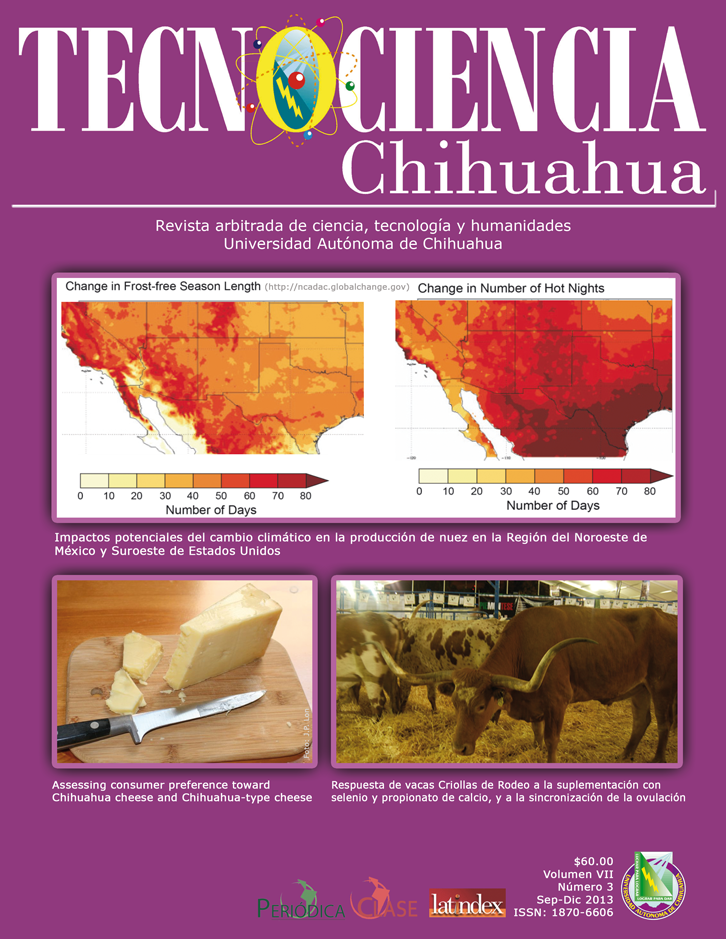Impactos potenciales del cambio climático en la producción de nuez en la Región del Noroeste de México y Suroeste de Estados Unidos
Potential impacts of climate change on pecan production in the Northwest Mexico and Southwest USA region*
Resumen
El nogal pecanero (Carya illinoinensis [Wangenh] K. Koch) es un cultivo económicamente importante tanto para México como para Estados Unidos de América. El Cambio climático (con incrementos en bióxido de carbono, incremento en la temperatura y reducciones en las precipitaciones pluviales) puede afectar seriamente la producción en las huertas nogaleras. Este artículo aborda algunos de los impactos potenciales del incremento del CO2 y de las temperaturas diarias en el crecimiento de los árboles de nogal, su dormancia y sus interacciones con los insectos- plaga.
Abstract
The pecan (Carya illinoinensis [Wangenh] K. Koch) is an economically important crop for both Mexico and the United States of America. The Climate Change (with increases in carbon dioxide, increases in temperature and reductions in rainfall) can seriously affect production in the orchards of walnut groves. This article discusses some of the potential impacts of increased CO2 and daily temperatures in the growth of walnut trees, its dormancy and its interactions with pest insect.
Keywords: Carya illinoinensis, pecan, climate change, drought, CO2, carbon dioxide, irrigation requirements
Citas
Amling, H.J. & K.A. Amling. 1980. Onset, intensity, and dissipation of rest in several pecan cultivars. J. Amer. Soc. Hort. Sci. 105(4):536-540. https://doi.org/10.21273/JASHS.105.4.536
Bassett, C.L., D.M. Glenn, P.L. Forsline, M.E. Wisniewski & R.E. Farrell Jr. 2011. Characterizing water use efficiency and water deficit responses in apple (Malus × domestica Borkh. and Malus sieversii (Ledeb.) M. Roem. HortScience 46(8):1079-1084. https://doi.org/10.21273/HORTSCI.46.8.1079
Baldocchi, D. & S. Wong. 2008. Accumulated winter chill is decreasing in the fruit growing regions of California. Climate Change 87(1):S153-166. https://doi.org/10.1007/s10584-007-9367-8
Bloom, A.J. 2009. As carbon dioxide rises, food quality will decline without careful nitrogen management. California Agric. 63(2):67-72. https://doi.org/10.3733/ca.v063n02p67
Dawson, G.R. 1983. New Mexico agriculture: A profile. New Mexico State University Cooperative Extension Service Circ.
Haller, R. 2011. Grower attributes orchard decline to climate changes. Pecan South 44(6):26-27.
Johnsen, Ø., O.G. Dǽhlen, G. Østreng & T. Scrøppa. 2005. Daylength and temperature during seed production interactively affect adaptive performance of Picea abies progenies. New Phytologist 168(3):589–596. https://doi.org/10.1111/j.1469-8137.2005.01538.x
Lombardini, L., H. Restrepo-Diaz & A. Volder. 2009. Photosynthetic light response and epidermal characteristics of sun and shade pecan leaves. J. Amer. Soc. Hort. Sci. 134(3):372-378. https://doi.org/10.21273/JASHS.134.3.372
McEachern, G.R., B.N. Wolstenholme & J.B. Storey. 1978. Chilling requirements of three pecan cultivars. HortScience. 13(6):694. https://doi.org/10.21273/HORTSCI.13.6.694a
National Assessment Synthesis Team, US Global Change Research Program. 2000. Climate Change Impacts on the United States. The Potential Consequences of Climate Variability and Change.
National Assessment Synthesis Team, US Global Change Research Program. 2000. Climate Change Impacts on the United States. The Potential Consequences of Climate Variability and Change. Appendix: The Science of Climate Change.
National Assessment Synthesis Team, US Global Change Research Program. 2000. Climate Change Impacts on the United States. The Potential Consequences of Climate Variability and Change. Agriculture.
National Oceanic and Atmospheric Administration National Climatic Data Center. 2013. Global surface temperature anomalies. National Oceanic and Atmospheric Administration National Climatic Data Center.
New Mexico Office of the State Engineer and Interstate Stream Commission. 2006. The impact of climate change on New Mexico’s water supply and ability to manage water resources. NMOSE.
New Mexico Department of Agriculture. 2010. 2010 New Mexico Agricultural Statistics. USDA National Agriculture Statistics Service in cooperation with New Mexico Department of Agriculture. https://tinyurl.com/24f5yhka
O’Neill, M.P. & J.P. Dobrowolski. 2011. Water and agriculture in a changing climate. HortScience 46(2):155-157. https://doi.org/10.21273/HORTSCI.46.2.155
Prior, S.A., G.B. Runion, S.C. Marble, H.H. Rogers, C.H. Gilliam & H.A. Torbert. 2011. A review of elevated atmospheric CO2 effects on plant growth and water relations: Implications for horticulture. HortScience 46(2):158-162. https://doi.org/10.21273/HORTSCI.46.2.158
Samani, Z., A.S. Bawazir, M.P. Bleiweiss & R.K. Skaggs. 2007. Estimating pecan water use through remote sensing in the Lower Rio Grande (pp. 253–260). En Proceedings of the USCID Fourth International Conference on Irrigation and Drainage, Sacramento, California, October 3-6, 2007.
Sammis, T. W., J.G. Mexal & D. Miller. 2004. Evapotranspiration of flood irrigated pecans. Agricultural Water Management 69(3):179–190. https://doi.org/10.1016/j.agwat.2004.05.005
Secretaría de Agricultura, Ganadería, Desarrollo Rural, Pesca y Alimentación. 2011. Comité Mexicano del sistema producto nuez, A.C. Cierre estadístico 2011. Servicio de Información Agroalimentaria y Pesquera.
Shackel, K. 2011. A plant-based approach to deficit irrigation in trees and vines. HortScience 46(2):173-177. https://doi.org/10.21273/HORTSCI.46.2.173
Sparks, D. 1993. Chilling and heating model for pecan budbreak. J. Amer. Soc. Hort. Sci. 118(1):29-35. https://journals.ashs.org/downloadpdf/journals/jashs/118/1/article-p29.pdf
Trumble, J.T. & C.D. Butler. 2009. Climate change will exacerbate California’s insect pest problems. California Agric. 63(2):73-78. https://escholarship.org/uc/item/0bz6g817
Zinati, G.M. 2011. Water management and plant performance in a changing climate: Introduction to colloquium. HortScience 46(2):152-154. https://doi.org/10.21273/HORTSCI.46.2.152
Derechos de autor 2020 TECNOCIENCIA Chihuahua

Esta obra está bajo licencia internacional Creative Commons Reconocimiento-NoComercial 4.0.







